PinotFile: 12.12 December 28, 2020
|
2020 Pinot Noir All-Americans
The All-Americans are selected not only for their fruity and flirty New World hedonism and description-defying sensuality, but also for the emotion they illicit. The All-Americans have a powerful charisma that is hard to describe. Another factor that comes into play in the decision-making process is distinctiveness. Many Pinot Noir wines taste the same and I look for uniqueness. There are a number of steps I take to arrive at the wines I recommend in the PinotFile each year. I do not taste the wines blind but strive for integrity, consistency and objectivity. There are two important reasons I do not taste blind. First, I prefer to evaluate wines in the same manner as the consumer experiences them. Second, an essential part of judging wine is to know what you are drinking. I tend to focus on current drinkability since most consumers drink their Pinot Noir wines relatively young. I most appreciate wines that are at or close to their best the days I taste them. That said, credence is given age-ability particularly in the context of balance. If a wine is balanced when I taste it young, it is almost certain to hold up for several years. A wine that is out of balance initially will never become balanced over time. The All-American Pinot Noir wines are judged on merit, independent of price, style, vintage or region of origin, and are listed by scores, beginning with the top-scoring wines. Since I was “semi-retired” in 2020, I tasted fewer wines and the list of All-Americans including Oregon will be shorter. I taste Pinot Noir in a consistently calm setting in my home office in the late morning. The wines are brought directly from my cellar and are tasted over an hour or two after opening at 63ºF in a relaxed, quiet atmosphere. I usually taste 6 or 7 wines at a time. I give the wines adequate time to open up and make several passes as I taste and spit each wine. Occasionally, I will decant a wine if the winemaker recommends it or if this will benefit the evaluation. I use wither Riedel Vinum Burgundy or Riedel Oregon Pinot Noir glasses exclusively. Often I will re-taste the wines briefly later the same day with dinner to replicate the consumer’s drinking experience, and or the following day from an opened and re-corked bottle. The latter helps to indicate quality and balance and an estimate of longevity. I have no monetary arrangement with any winegrower, winery, winemaker, retailer or wholesaler and accept no advertising. I review mostly wines sent to me for review, but some are purchased directly from wineries or retailers. I do not charge wineries for inclusion of reviews in the PinotFile. The All-American awards are unique in that the winners include trophy and cult Pinot Noir wines that are infrequently if ever, reviewed by major wine publications or wine competition tasting panels. If there is an All- American Pinot Noir you can’t obtain, keep in mind that there will always be another vintage. The wine may not be the same song, but it will be the same composer. Membership on winery mailing lists and in winery wine clubs are both essential methods of insuring the acquisition of a producer’s coveted Pinot Noir wines. For the Pinot Noir wines that were left out of the awards this year, the words of Mark Twain ring true, “It is better to deserve honors and not have them than to have them and not deserve them.”
2020 California & Oregon Pinot Noir All-Americans
2017 Pisoni Pisoni Estate Santa Lucia Highlands Pinot Noir $90 98 2017 Adelaida HMR Estate Vineyard Adelaida District Paso Robles Pinot Noir $N/A 97 2014 Hanzell Ambassador’s 1953 Sonoma Valley Pinot Noir $145 97 2016 Fulcrum Gap’s Crown Vineyard Petaluma Gap Pinot Noir $68 97 2014 J. Rochioli Vineyards & Winery West Block Russian River Valley Pinot Noir $100 97 2015 J. Rochioli Vineyards & Winery West Block Russian River Valley Pinot Noir $112 97 2016 Soliste Renaissance Sonoma Coast Pinot Noir $85 97
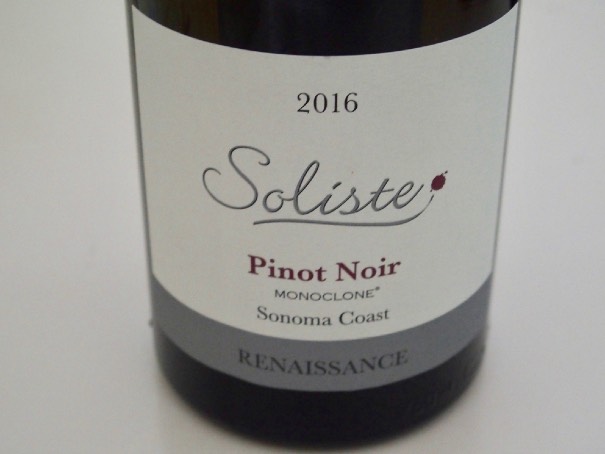 2018 Adelaida HMR Estate Vineyard Adelaida District Paso Robles Pinot Noir $80 96 2018 Benovia Martaella Estate Russian River Valley Pinot Noir $65 96 2017 Brousseau Wines Old Vines Brosseau Vineyard Chalone Pinot Noir $53 96 2014 Ceritas Old Shop Block Hellenthal Vineyard Fort Ross-Seaview Pinot Noir $72 96 2017 J. Rochioli Vineyards & Winery Little Hill Russian River Valley Pinot Noir $86 96 2017 J. Rochioli Vineyards & Winery River Block Russian River Valley Pinot Noir $90 96 2018 Pisoni Pisoni Estate XX Anniversary Santa Lucia Highlands Pinot Noir $90 96 2017 RAEN Home Field Fort Ross-Seaview Sonoma Coast Pinot Noir $80 96
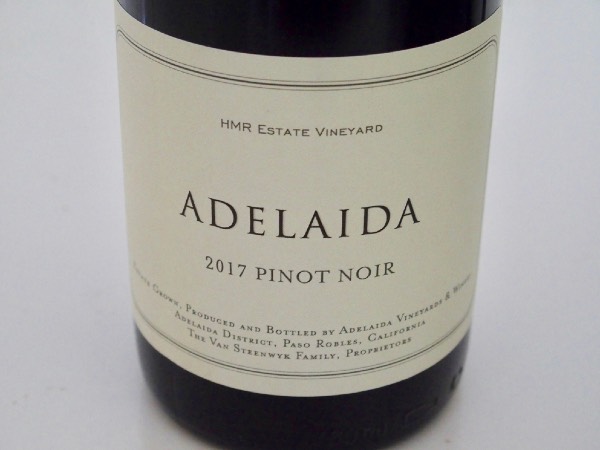 2016 Adelaida HMR Estate Vineyard Adelaida District Paso Robles Pinot Noir $N/A 95 2017 Ancien Combsville-Haynes Old Block Napa Valley Pinot Noir $68 95 2018 Beauregard Vineyards Beauregard Ranch Santa Cruz Mountains Pinot Noir $60 95 2017 Husch Vineyards Knoll Anderson Valley Pinot Noir $42 95 2017 J. Rochioli Vineyards & Winery Three Corner Russian River Valley Pinot Noir $90 95 2017 J. Rochioli Vineyards & Winery Sweetwater Russian River Valley Pinot Noir $86 95 2016 Kelley Fox Wines Maresh Vineyard Red Barn Blocks Dundee Hills Pinot Noir $75 95 2017 Lynmar Estate Old Vines Quail Hill Vineyard Russian River Valley Pinot Noir $80 95 2016 Porter Creek Hillside Vineyard Russian River Valley Pinot Noir $72 95 2012 Privé Vineyard le nord Chehalem Mountains Pinot Noir $55 95 2009 Rhys Horseshoe Vineyard Santa Cruz Mountains Pinot Noir $89 95 2018 Rivers-Marie Summa Vineyard Old Vines Sonoma Coast Pinot Noir $80 95 2014 Woodenhead Ritchie Vineyard Cinder Cone Russian River Valley Pinot Noir $65 95 2015 Woodenhead Ritchie Vineyard Cinder Cone Russian River Valley Pinot Noir $65 95 2017 Peter Michael “La Caprice” Fort Ross-Seaview Pinot Noir $130 96 2018 RAEN Freestone Occidental Sonoma Coast Pinot Noir $90 96 2016 School House Vineyard Napa Valley Pinot Noir $65 96
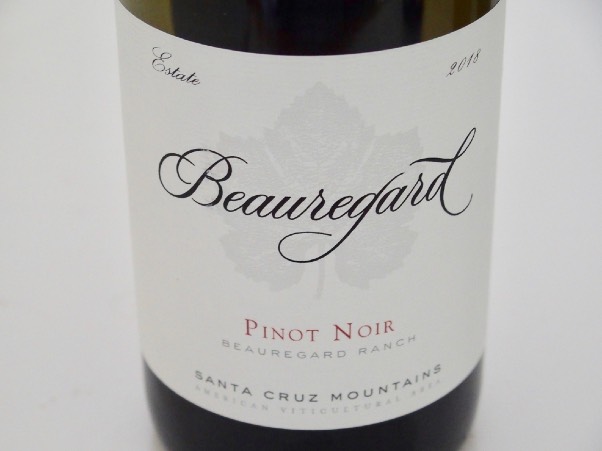 2014 Adelaida HMR Estate Vineyard Adelaida District Paso Robles Pinot Noir $N/A 94 2017 Alma Fria Holtermann Vineyard Sonoma Coast Pinot Noir $70 94 2018 Benovia Tilton Hill Estate Sonoma Coast Pinot Noir $65 94 2018 Benovia Bella Una Russian River Valley Pinot Noir $85 94 2015 Big Basin Woodruff Family Vineyard Santa Cruz Mountains Pinot Noir $65 94 2017 Big Basin Ferrari Family Vineyard Santa Cruz Mountains Pinot Noir $60 94 2017 Castalia Rochioli Vineyard Russian River Valley Pinot Noir $60 94 2009 Donum Estate Thomas Carneros Pinot Noir $100 94 2017 Evesham Wood Sojeau Vineyard Eola-Amity Hills Pinot Noir $36 94 2017 Evesham Wood Temperance Hill Vineyard Eola-Amity Hills Pinot Noir $36 94 2017 Evesham Wood Cuvée J Eola-Amity Hills Pinot Noir $55 94 2017 Gary Farrell Hallberg Vineyard Russian River Valley Pinot Noir $55 94 2017 Hartford Court Arrendell Vineyard Russian River Valley Pinot Noir $100 94 2012 LaRue Emmaline Ann Vineyard Sonoma Coast Pinot Noir $70 94 2009 Littorai One Acre Anderson Valley Pinot Noir $N/A 94 2018 Phelps Creek Cuvée Alexandrine Columbia Gorge Pinot Noir $N/A 94 2018 RAEN Fort Ross Seaview Sea Field Sonoma Coast Pinot Noir $80 94 2014 Sanford Single Block Founders’ Vines Sta. Rita Hills Pinot Noir $115 94 2015 School House Vineyard Napa Valley Pinot Noir $70 94 2017 Truchard Old Block Carneros Pinot Noir $85 94 2016 Tulocay Haynes Vineyard Napa Valley Pinot Noir $40 94 2016 Williams Selyem Burt Williams Morning Dew Ranch Anderson Valley Pinot Noir $85 94 2017 Windy Oaks Old Vine Chalone Pinot Noir $65 94 2013 Woodenhead Ritchie Vineyard Cinder Cone Russian River Valley Pinot Noir $N/A 94
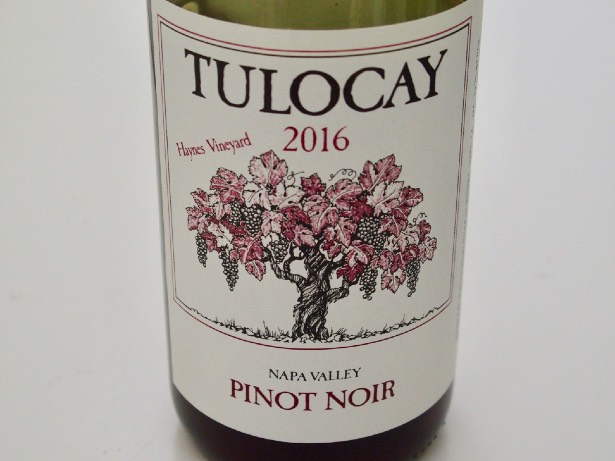
Pinot Noir Labels That Catch the Eye
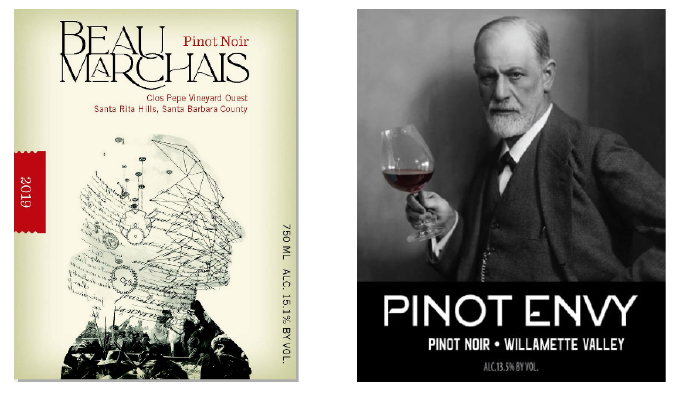
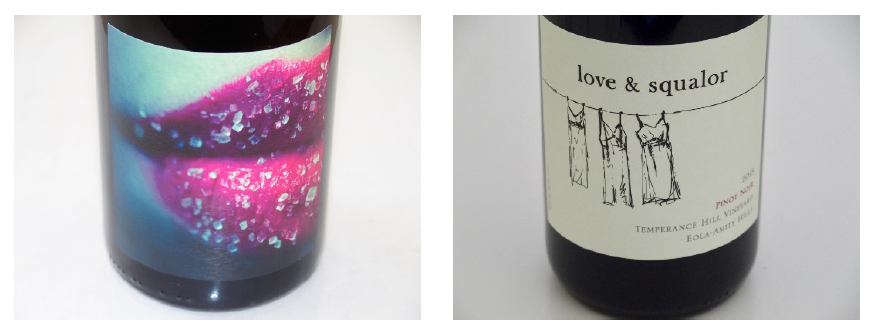
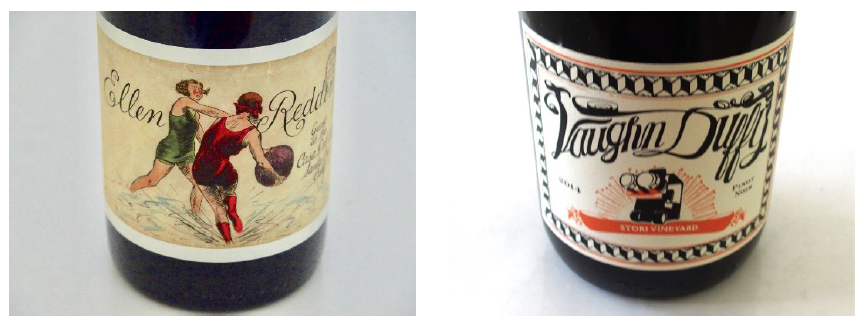
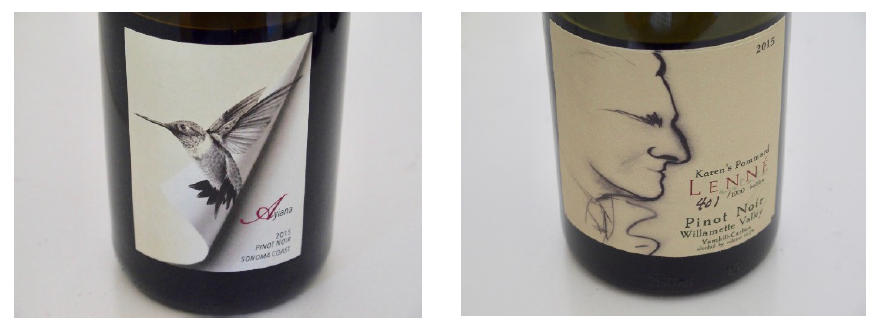
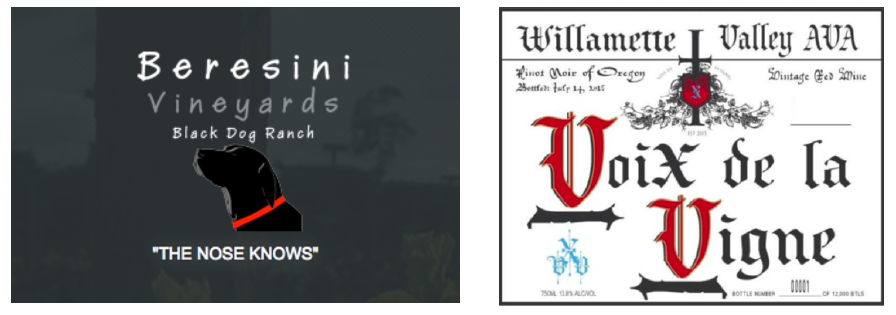
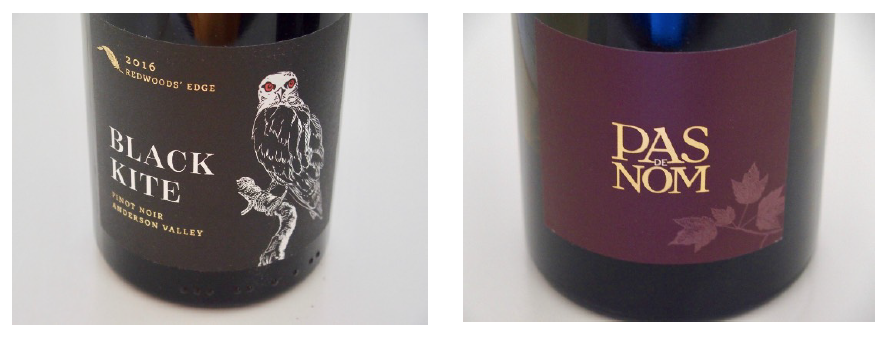
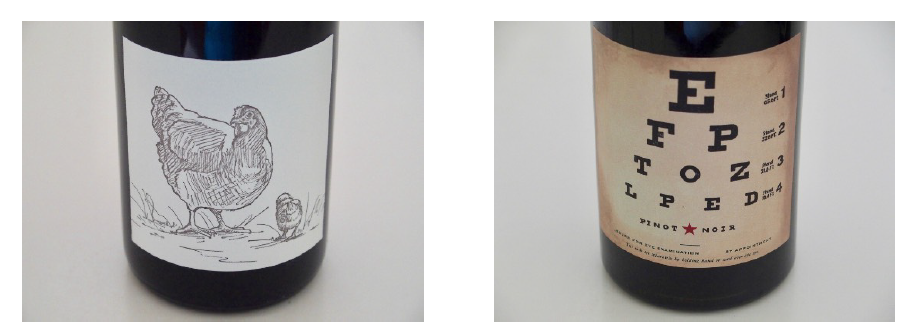
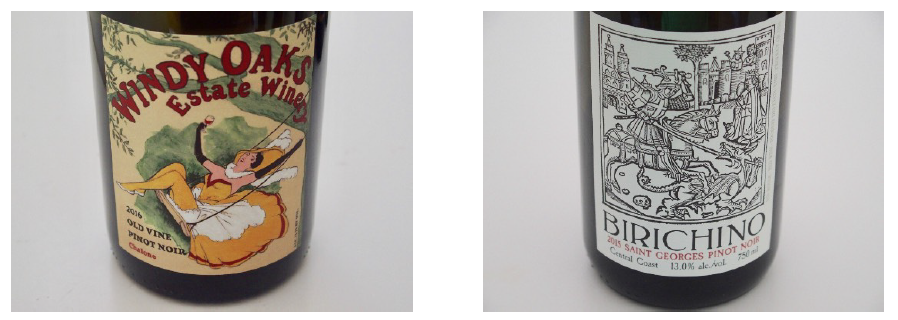
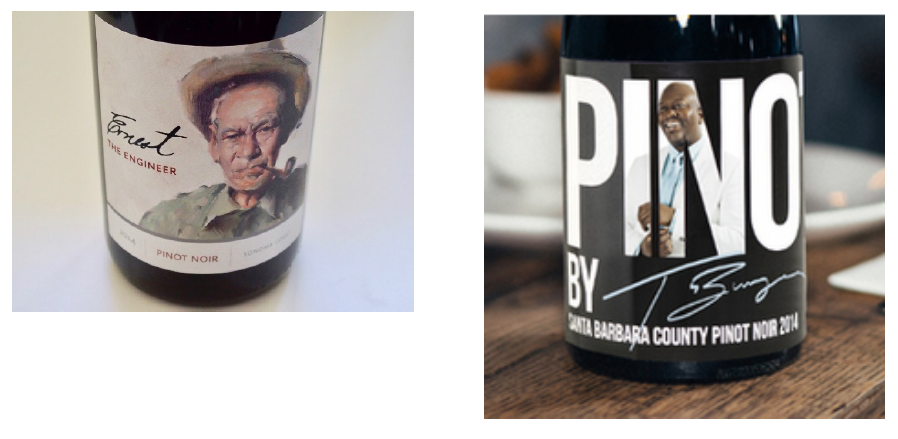
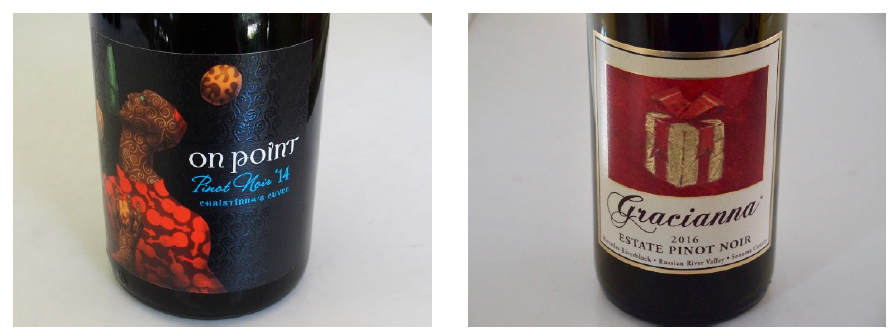
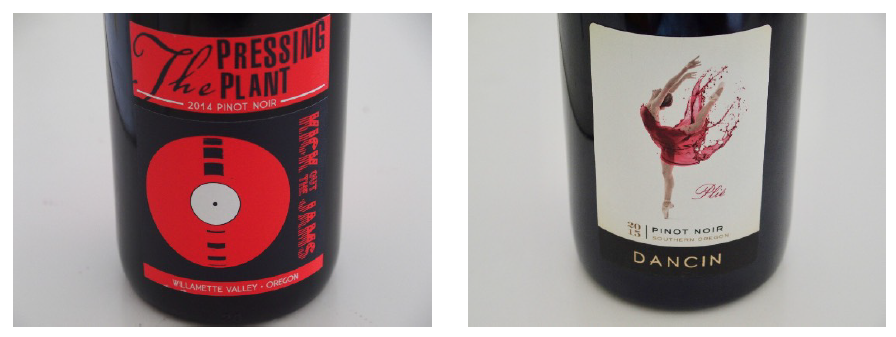
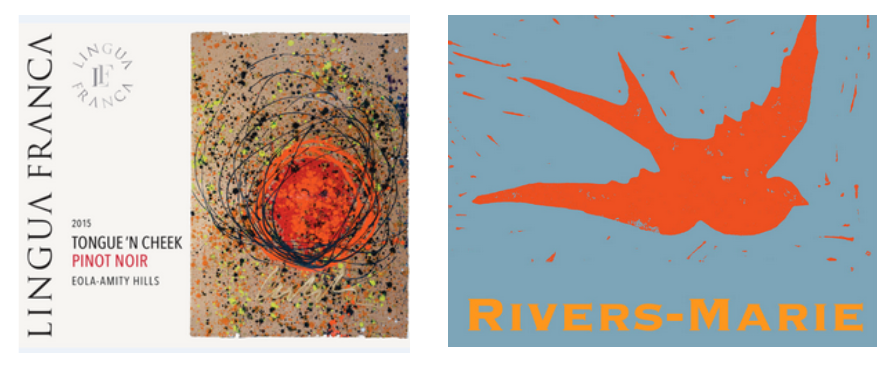
Bah Humbug
Bah Humbug to alcohol percentages on labels in such a tiny font that they defy readability except for those young people gifted with 2015 vision. The TTB requires that alcohol content appears on the label no smaller than 1 millimeter and no larger than 3 millimeters. I urge wineries to put the alcohol percentage somewhere on the front or back label in a size font with enough contrast to easily read. While you are at it, can you please put the “honest” alcohol percentage on the label? Bah Humbug to heavy glass Pinot Noir bottles. Wine writers hate them, sommeliers despise them, and I truly dislike them. They don’t fit into most racking and they are unwieldy to pour from. Lifting cases of heavy bottles can lead to serious back problems (a case of heavy bottles weighs about 43 pounds) and cases of heavy bottles are more expensive to ship. Glass represents anywhere from 50 to 73 percent of a winery’s carbon footprint and switching to lighter weight bottles can not only reduce the carbon footprint but save wineries money. The popularity among wineries of heavy bottles of Pinot Noir is loosely based on the perception that consumers will consider the wine contained therein of higher quality and worth the often higher price. I don’t believe wine buyers pay much attention to this and wine critics are not impressed or influenced by massive bottles and huge punts.
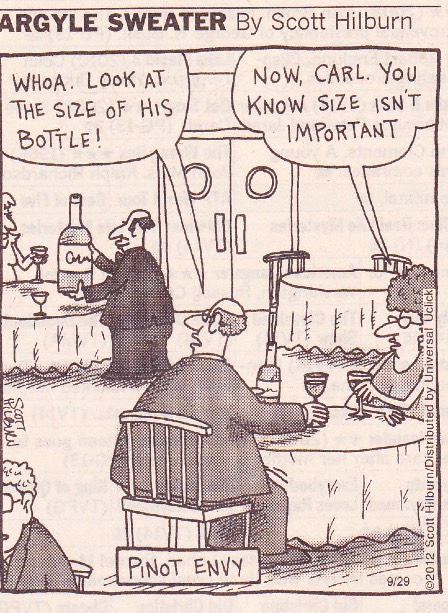 Bah Humbug to generously oaky Pinot Noir. It is true that no one is certain what Pinot Noir is supposed to taste like, but I seriously doubt that oak is high on the list. I cannot think of drinking a Pinot Noir in the past and wishing the wine had more oak. Bo Barrett, winemaker at Chateau Montelena once said, “New oak is like garlic or chili in cooking. If you use too much of it you will kill the flavor.” Bah Humbug to the explosion of scores of domestic Pinot Noir at or above 90 out of 100 points, the result of so-called “creeping grade inflation.” It seems to me that every winery I know of has a Pinot Noir that has scored 90 or above by some publication or wine writer. Some wineries even have the audacity to quote a high score without even giving the source of the score. The October 15, 2020, issue of the Wine Spectator featured California Pinot Noir. The magazine’s head reviewer for California Pinot Noir, Kim Marcus, reviewed more than 600 wines (mainly 2017 and 2018 vintages) and found that 375 wines reached 90 points or higher (63%) and 36 wines scored in the 94- to 95-point range. Wine writers have pointed out that this grade inflation decries the 100-point scoring system because so many wines are considered superior. One caveat is that some of this grade inflation can be attributed to the increasing quality of California Pinot Noir. I am the first to admit that emotion and excitement that overcomes me when I truly find a desirable Pinot Noir leads me to award a high score. On the other hand, reviews of wine that disappoint me are not even published in the PinotFile (in agreement with the producer). This escalation of scores is all the more reason to avoid chasing high-scoring wines and instead pursue a producer with a broad work of excellence. Bah Humbug to consumers who equate price with quality or quality with price. They believe the best Pinot Noir costs the most and vice versa. It is true that you get what you pay for and my 2020 All-American Pinot Noirs ranged in price from $36 to $145 with a median price of $76 and a mode price of $65. While Pinot Noir is expensive to farm and produce making many of the highest quality Pinot Noir wines expensive, many modestly priced wines can offer equal enjoyment. My suggestion is to gather together several wine drinking friends, bag a dozen Pinot Noir wines priced from $10 to $100 and taste and rate individual preferences blind. If you can’t bear to do it with friends, do it by yourself with your dog by your side because he will be oblivious to your embarrassment. Bah Humbug to those who are reluctant to trust their own palate. If you like it, then it is a good wine. There is no accounting for taste. As wine importer Neal Rosenthal has proclaimed, “Your taste is your own. Your patrimony. You play with it as you play with your hands.” Wine critics, including the Prince, can enhance and direct your wine experience, but they cannot be your wine experience. There are few really bad domestic Pinot Noir wines from reputable sources on the market today. The consumer should be more concerned with differences than what is good or bad. In this same vein, avoid drinking labels. As UC Davis Professor Dr. Maynard Amerine once said, “It is not the year, the producer, or even the label that determines the quality of the wine. It is the wine in the glass, whatever the label or producer or year.” Perhaps we should look to women for guidance. Women don’t care what men think. They do not drink a Pinot Noir because men like it or because it scored 95/100. They drink it because it tastes good. Bah Humbug to uninformative, lackluster winery websites. Wineries should disclose on their website as much information about themselves and their wines as possible. Pinot geeks clamour for it and wine writers need it. Provide copies of all wine labels since these visual images help the consumer to connect and assist the wine press in spreading the winery’s image. Include descriptions of all wines with truthful information about the style of the wine and how it tastes. This information is more important than a score. Include an e-mail address for contacting the winery owner or winemaker for questions. Keep the information current.
I don’t want readers to get the impression I am a scrooge and the Bah Humbug mentions are not meant to be taken too seriously. Pinot Noir has been the glue that has held us together during the gloom of 2020. Continue to support your favorite producers of Pinot Noir and look forward to a bright 2021.

Punt Tales
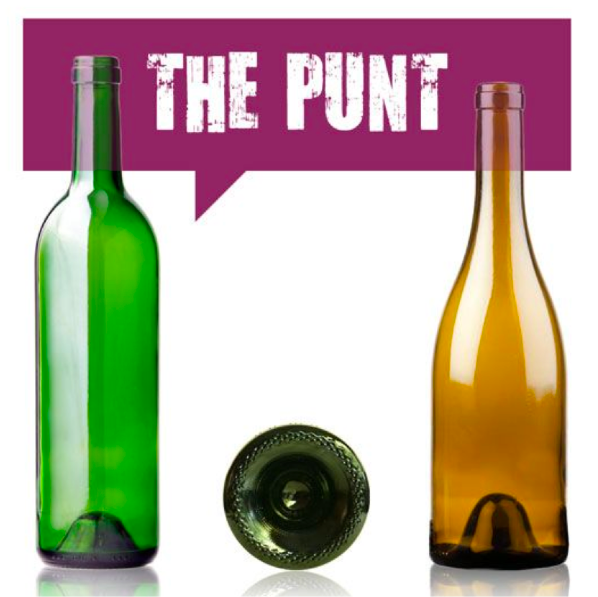 The punt at the bottom of a bottle is a deep indentation in a bottle’s butt. It diffuses pressure and helps balance the gas which is important in Champagne bottles. Still wine bottles do not need a punt, but many producers keep it as tradition. Punts date to the time that glassblowers produced bottles by hand using a wood stick to hold the glass from the neck end. After forming the bottle, the glassblower pulled out the stick, creating a punched-in bottom. Some producers of Pinot Noir have an astonishingly deep punt. Many years ago, a British study showed that it was possible to determine the value of the bottle of wine by feeling the depth of its dimple. Previously this was thought to be an urban myth. Some researchers with nothing better to do actually measured differently priced bottles of wine. It was shown that more expensive wines had deeper punts. The relationship between depth and price could be expressed by the equation: price of bottle-punt depth in millimeters + $5.64/4.314. The homemade depth gauge that was used by researchers to make the measurements was auctioned on eBay. I went into my own cellar to feel a few punts. I used my two fingers (index and middle) as a depth gauge and graded the depth of the punt as none, first knuckle and second knuckle. Some punts have a nipple at the depth of the depression that can slightly affect the measurement. After sampling several bottles, I found that the scientific results reported by the British researchers are valid but not infallible. Some of my lowly Pinot Noir wines (for unwanted guests, relatives and cooking) had no dimple at all and a very few had a good-sized punt. Most Pinot Noir bottles had a one-knuckle punt that seems to be the most common punt size. When you are at a party you can amaze the crowd by feeling the punt depth and picking out the most expensive wines. When you are at your local wine retailer, you can wager a bottle of good Pinot Noir on whether you can tell the more expensive bottle by holding the bottle and subtlety putting you two fingers into the punt. Just don’t overdo it, people might think you are some kind of weirdo.
PINOT NOIR: A WWII Novel
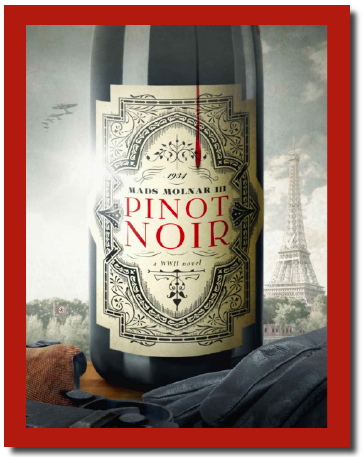 The title of this book caught my eye and I found it to be a good read worth recommending. The night before the Nazis raid his cellar in 1940, a French vintner poisons a case of his best Pinot Noir as a way of getting back at the Nazis. The Nazis take the bait and when the Pinot Noir starts poisoning high-ranking German officers, detective Mads Molnar gets a phone call from the Gestapo and strikes a deal. Recover the bottlers and get a ticket out of the Nazi territory and a pardon for killing a fascist. Every chapter of Pinot Noir follows one of the 12 poisoned bottles in the case. But Molnar has a big problem. A Nazi detective, 300-pound Wolfram Bastick is also on the case after the poisoned wine killed his father. Meanwhile, Bastick’s gorgeous fiancé is plotting to murder him. Molnar must secretly recover the wine, win over Bastick’s fiancé, escape the Nazis and hi-tale it out of Germany without getting killed. The author, Mads Molnar III, picked up this story from his grandfather, Mads Molnar I. His grandfather participated in World War I and after the war became a detective until his death. Grandfather Molnar use to tell Mads Molnar III about true events that made up this story and the author picked up where he left off. This is not a story about Pinot Noir per see, rather an adventure story with many compelling twists and turns that moves along quickly. PINOT NOIR: A WWII Novel, Mads Molnar III, 216 pages, 2020, paperback, $18.99 (Amazon) and Kindle. |